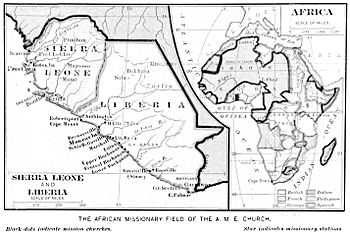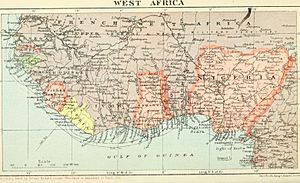Sierra Leone Colony and Protectorate facts for kids
Quick facts for kids
Colony and Protectorate of Sierra Leone
|
|||||||||||
|---|---|---|---|---|---|---|---|---|---|---|---|
| 1808–1961 | |||||||||||
|
Flag
(1916–1961) |
|||||||||||
|
Motto: Auspice Britannia liber
(Latin: "Free under the protection of Britain") |
|||||||||||

The Colony and Protectorate of Sierra Leone in 1899
|
|||||||||||
| Status | British colony | ||||||||||
| Capital | Freetown | ||||||||||
| Official languages | English | ||||||||||
| Recognised national languages | Krio | ||||||||||
| Religion | Christianity, Islam | ||||||||||
| Government | British colony | ||||||||||
| Monarch | |||||||||||
|
• 1808–1820 (first)
|
George III | ||||||||||
|
• 1952–1961 (last)
|
Elizabeth II | ||||||||||
| Governor | |||||||||||
|
• 1808 (first)
|
Thomas Ludlam | ||||||||||
|
• 1956–1961 (last)
|
Maurice Dorman | ||||||||||
| Prime Ministera | |||||||||||
|
• 1954–1961
|
Milton Margai | ||||||||||
| Legislature | Legislative Council (1863–1954) House of Representatives (after 1954) |
||||||||||
| Historical era | Abolitionism New Imperialism Decolonisation of Africa |
||||||||||
|
• Colony established
|
1 January 1808 | ||||||||||
|
• Protectorate established
|
31 August 1896 | ||||||||||
|
• Independence as Sierra Leone
|
27 April 1961 | ||||||||||
| Area | |||||||||||
| 1924 | 81,999 km2 (31,660 sq mi) | ||||||||||
| Population | |||||||||||
|
• 1808
|
2,000 | ||||||||||
|
• 1924
|
1,541,311 | ||||||||||
|
• 1955
|
2,051,845 | ||||||||||
|
• 1960
|
2,181,701 | ||||||||||
| Currency | Pound sterling (1808–1912) British West African pound (1912–1961) |
||||||||||
| ISO 3166 code | SL | ||||||||||
|
|||||||||||
| Today part of | Sierra Leone | ||||||||||
|
|||||||||||
The Colony and Protectorate of Sierra Leone was a part of the British Empire. It was governed by Britain from 1808 until 1961. This period stretched from the time when Britain was working to end slavery to when many African countries gained their independence.
The Colony part was the area around Freetown. It was set up in 1808. The Protectorate was created later in 1896. It covered the inland areas of what is now Sierra Leone.
The motto of this British territory was Auspice Britannia liber. This is Latin for "Free under the protection of Britain." This motto later appeared on Sierra Leone's flag and coat of arms.
Contents
History of British Sierra Leone
Why Sierra Leone Was Founded
In the 1780s, many freed slaves lived in London. Some were Black Pioneers who had fought for the British in the American Revolutionary War. Many of these people were very poor and needed help. A group called the Committee for the Relief of the Black Poor decided to help them move to Africa.
This plan was called the Sierra Leone Resettlement Scheme. People like Granville Sharp thought it was a good way to show that black people could build a successful colony. The British government also liked the idea. They wanted to resettle many poor citizens. The Prime Minister, William Pitt the Younger, believed it was important to send these people somewhere else.
The British made a deal with a Temne chief named King Tom. They got land on the coast for the new settlement. In 1787, a ship arrived with 411 people. These included freed slaves, Black Pioneers, and their families. This new place was first called Granville Town.
Life was very hard for the first settlers. Many died in the first year. Some even ended up working for local slave traders. The settlers who remained took land from a local chief. He fought back and attacked the settlement. Only 64 settlers were left. Some were captured and sold into slavery. The remaining colonists had to arm themselves for safety. In 1789, King Jemmy, King Tom's successor, burned the colony.
A new settlement was built in a different spot. It became known as Freetown. In 1792, about 1,200 Nova Scotian Settlers arrived. They were freed slaves and Black Pioneers from Nova Scotia. In 1800, another 551 Jamaican Maroons came from Jamaica. The children and grandchildren of these settlers became known as the Sierra Leone Creole people.
The British government ended the slave trade in 1807. In 1808, Britain took full control of Sierra Leone. It became a Crown colony, which meant it was directly ruled by the British Crown.
Growth and Changes (1800s to Mid-1900s)
On October 17, 1821, the Sierra Leone Colony became part of British West Africa. This was a group of British colonies in West Africa. Freetown was the capital of British West Africa for its entire existence.
On August 31, 1896, the inland part of Sierra Leone became a British protectorate. This created the Sierra Leone Protectorate. Its borders were set with French Guinea and Liberia.
On January 1, 1928, the British ended domestic slavery in Sierra Leone.
In 1930, a British company called Sierra Leone Development Company (DELCO) began mining iron ore. In 1932, another British company, Sierra Leone Selection Trust, started mining diamonds.
In 1937, a "Native Administration" system was introduced. This system was similar to how Lord Frederick Lugard ruled in northern Nigeria. It allowed local chiefs to have some power under British control.
In 1938, I. T. A. Wallace-Johnson started the West African Youth League in Freetown. This group helped workers form new trade unions. They worked to improve conditions and challenge the colonial government.
When World War II started in 1939, emergency rules were used. Wallace Johnson was put in prison because of his political activities.
In 1947, a new plan for the colony's government was suggested. It gave more power in the Legislative Council to the people living in the protectorate.
The Path to Independence
After World War II, many people in Sierra Leone wanted independence. Politicians like Sir Milton Margai led this movement. They campaigned for independence within the colonial government. Throughout the 1950s, they won elections based on these goals.
Margai and other Sierra Leonean leaders asked the British government for independence. The British Prime Minister, Harold Macmillan, supported giving independence to Britain's African colonies. He told his government to listen to these requests.
The next steps were to create a peaceful way for power to be transferred. A vote was held in Sierra Leone to ask if people wanted independence. Most people voted yes. Macmillan knew they would vote yes, but this vote was important to show popular support for Britain leaving.
After the vote passed, elections were held to choose the new government. Margai and his supporters won these elections. In May 1957, Sierra Leone had its first parliamentary election. Margai's party, the Sierra Leone People's Party (SLPP), was very popular. They won most seats in Parliament. Margai was re-elected as Chief Minister.
On April 20, 1960, Margai led a group of 24 Sierra Leonean representatives. They met with the British government in London. They discussed the details of independence. On May 4, 1960, the United Kingdom agreed to grant Sierra Leone independence on April 27, 1961.
Independence Day
On April 27, 1961, Sierra Leone became independent. A big ceremony was held in Freetown. Bands played music. The Union Jack, the British flag, was slowly lowered. It was respectfully folded and given to the Duke of Kent (Prince Edward).
Then, the new blue, white, and green flag of Sierra Leone was raised. The Duke of Kent and Margai shook hands. The crowd cheered loudly. The last British Governor of Sierra Leone became the Governor-General. This meant he was Queen Elizabeth II's representative in the new country.
There was a short state of emergency. The opposition leader, Siaka Stevens, had lost the elections to Margai. He boycotted the ceremony. People feared his party, the All People's Congress (APC), might cause trouble. Stevens was placed under house arrest before the ceremony. He was released soon after.
However, the transfer of power was completely peaceful. Prime Minister Harold Macmillan and Queen Elizabeth sent messages of congratulations. Sierra Leone became an independent country. It had its own parliament and Prime Minister. But Queen Elizabeth remained the head of state. This began the history of the Dominion of Sierra Leone.
The Colony and Protectorate of Sierra Leone ended in 1961. Sierra Leone became independent from the United Kingdom. Elizabeth II was the Queen of Sierra Leone. She remained head of state for ten years, until 1971. Then, Sierra Leone became a republic.
More to Explore
- Chief Justice of Sierra Leone
- Governor of Sierra Leone




